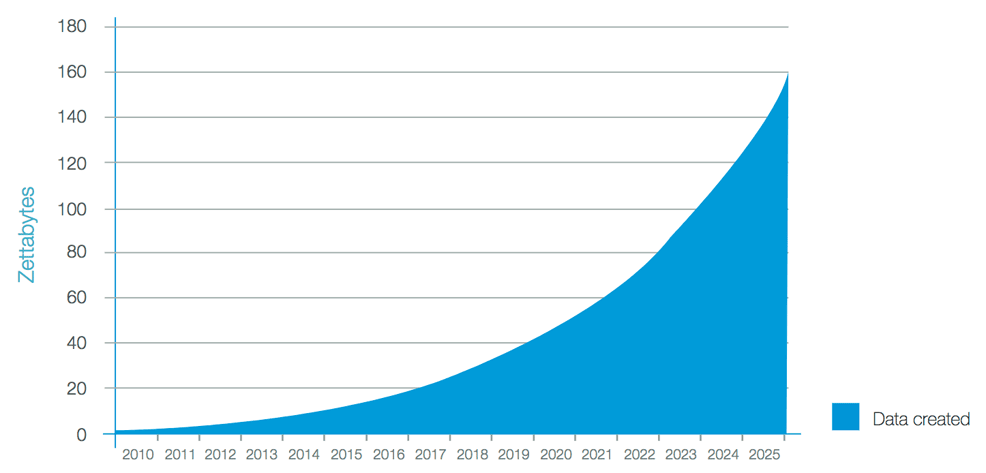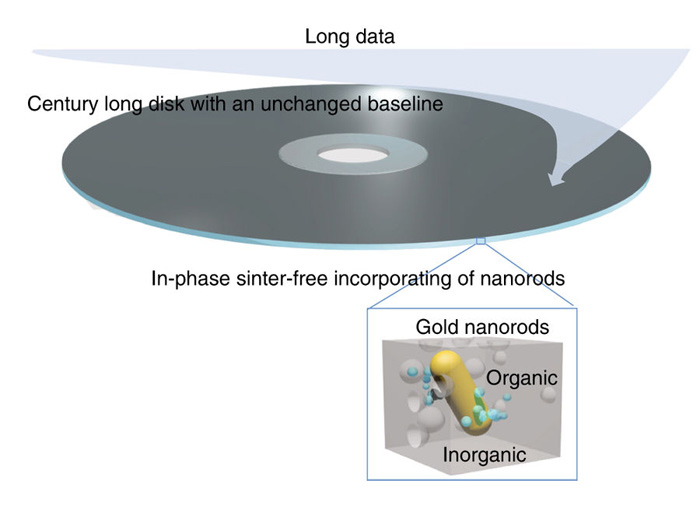
12th April 2018 Next-gen optical disk holds 10TB of data for 600 years Scientists from Australia and China have used gold nanomaterials to demonstrate a new high-capacity optical disk able to hold data securely for more than 600 years, while using 1,000 times less power.
A new technology could provide more cost-efficient and energy-efficient global data storage, while enabling the critical pivot from Big Data to "Long Data" – opening up new realms of scientific discovery. The recent explosion of Big Data and cloud storage has led to a parallel explosion in power-hungry data centres. These facilities not only use up colossal amounts of energy – consuming about 3% of the world's electricity supply – but generally rely on hard disk drives with limited capacity (2TB per disk) and short lifespans (only two years). Now scientists from the Royal Melbourne Institute of Technology (RMIT) and Wuhan Institute of Technology, China, have used gold nanomaterials to demonstrate a next-generation optical disk with up to 10TB capacity – a storage leap of 400% – and a six-century lifespan. This technology could radically improve the efficiency of data centres, using 1,000 times less power than a hard disk centre, by requiring far less cooling and doing away with the energy-intensive task of data migration every two years. Optical disks are also inherently far more secure than hard disks.
"All the data we're generating in the Big Data era – over 2.5 quintillion bytes a day – has to be stored somewhere, but our current storage technologies were developed in different times," said lead investigator, RMIT's Distinguished Professor Min Gu. "While optical technology can expand capacity, the most advanced optical disks developed so far have only 50-year lifespans. "Our technique can create an optical disk with the largest capacity of any optical technology developed to date, and our tests have shown it will last over half a millennium. While there is further work needed to optimise the technology – and we're keen to partner with industrial collaborators to drive the research forward – we know this technique is suitable for mass production of optical disks, so the potential is staggering." The world is shifting from Big Data towards Long Data, which enables new insights to be discovered through the mining of massive datasets that capture changes in the real world over decades and centuries.
Exponential growth of data in the world. Credit: IDC.
"Long Data offers an unprecedented opportunity for new discoveries in almost every field – from astrophysics to biology, social science to business – but we can't unlock that potential without addressing the storage challenge," said co-author Dr Qiming Zhang, from the RMIT's School of Science. "For example, to study the mutation of just one human family tree, 8 terabytes of data is required to analyse genomes across 10 generations. In astronomy, the Square Kilometre Array (SKA) radio telescope will produce 576 petabytes of raw data per hour. "Meanwhile the Brain Research through Advancing Innovative Neurotechnologies (BRAIN) Initiative to 'map' the human brain is handling data measured in yottabytes, or one trillion terabytes. Developing storage devices with both high capacity and long lifespan is essential, so we can realise the impact that research using Long Data can make in the world." The novel technique behind this technology – developed over five years – combines gold nanomaterials with a hybrid glass material that has outstanding mechanical strength. The research progresses earlier groundbreaking work by Gu and his team that smashed through the seemingly unbreakable optical limit of Blu-ray and enabled data to be stored across the full spectrum of visible light rays. The researchers have demonstrated optical long data memory in a novel nanoplasmonic hybrid glass matrix, different to the conventional materials used in optical discs. Glass is a highly durable material, able to last 1,000 years, but has limited storage capacity because of its inflexibility. The researchers combined glass with an organic material – halving its lifespan, but radically increasing capacity. To create the nanoplasmonic hybrid glass matrix, gold nanorods were incorporated into a hybrid glass composite, known as organic modified ceramic. The researchers chose gold because, like glass, it is robust and durable. Gold nanoparticles allow information to be recorded in five dimensions – the three dimensions in space, plus colour and polarisation. The technique relies on a sol-gel process, which uses chemical precursors to produce ceramics and glasses with better purity and homogeneity than conventional processes. The team's paper, "High-capacity optical long data memory based on enhanced Young's modulus in nanoplasmonic hybrid glass composites" is published in the journal Nature Communications.
Comments »
If you enjoyed this article, please consider sharing it:
|









